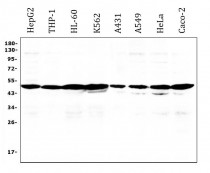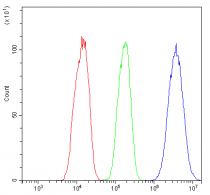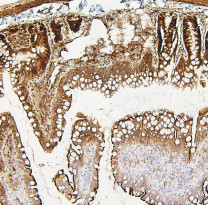ARG43116
anti-NR1I2 / PXR antibody
anti-NR1I2 / PXR antibody for Flow cytometry,IHC-Formalin-fixed paraffin-embedded sections,Western blot and Human,Mouse,Rat
Overview
| Product Description | Rabbit Polyclonal antibody recognizes NR1I2 / PXR |
|---|---|
| Tested Reactivity | Hu, Ms, Rat |
| Tested Application | FACS, IHC-P, WB |
| Host | Rabbit |
| Clonality | Polyclonal |
| Isotype | IgG |
| Target Name | NR1I2 / PXR |
| Antigen Species | Human |
| Immunogen | Recombinant protein corresponding to E7-A395 of Human NR1I2 / PXR. |
| Conjugation | Un-conjugated |
| Alternate Names | PAR; ONR1; PARq; Steroid and xenobiotic receptor; Nuclear receptor subfamily 1 group I member 2; PXR; BXR; Orphan nuclear receptor PAR1; Orphan nuclear receptor PXR; SXR; PAR2; PAR1; PRR; SAR; Pregnane X receptor |
Application Instructions
| Application Suggestion |
|
||||||||
|---|---|---|---|---|---|---|---|---|---|
| Application Note | IHC-P: Antigen Retrieval: Heat mediation was performed in Citrate buffer (pH 6.0) for 20 min. * The dilutions indicate recommended starting dilutions and the optimal dilutions or concentrations should be determined by the scientist. |
||||||||
| Observed Size | ~ 50 kDa |
Properties
| Form | Liquid |
|---|---|
| Purification | Affinity purification with immunogen. |
| Buffer | 0.2% Na2HPO4, 0.9% NaCl, 0.05% Sodium azide and 4% Trehalose. |
| Preservative | 0.05% Sodium azide |
| Stabilizer | 4% Trehalose |
| Concentration | 0.5 mg/ml |
| Storage Instruction | For continuous use, store undiluted antibody at 2-8°C for up to a week. For long-term storage, aliquot and store at -20°C or below. Storage in frost free freezers is not recommended. Avoid repeated freeze/thaw cycles. Suggest spin the vial prior to opening. The antibody solution should be gently mixed before use. |
| Note | For laboratory research only, not for drug, diagnostic or other use. |
Bioinformation
| Database Links | |
|---|---|
| Gene Symbol | NR1I2 |
| Gene Full Name | nuclear receptor subfamily 1, group I, member 2 |
| Background | This gene product belongs to the nuclear receptor superfamily, members of which are transcription factors characterized by a ligand-binding domain and a DNA-binding domain. The encoded protein is a transcriptional regulator of the cytochrome P450 gene CYP3A4, binding to the response element of the CYP3A4 promoter as a heterodimer with the 9-cis retinoic acid receptor RXR. It is activated by a range of compounds that induce CYP3A4, including dexamethasone and rifampicin. Several alternatively spliced transcripts encoding different isoforms, some of which use non-AUG (CUG) translation initiation codon, have been described for this gene. Additional transcript variants exist, however, they have not been fully characterized. [provided by RefSeq, Jul 2008] |
| Function | Nuclear receptor that binds and is activated by variety of endogenous and xenobiotic compounds. Transcription factor that activates the transcription of multiple genes involved in the metabolism and secretion of potentially harmful xenobiotics, drugs and endogenous compounds. Activated by the antibiotic rifampicin and various plant metabolites, such as hyperforin, guggulipid, colupulone, and isoflavones. Response to specific ligands is species-specific. Activated by naturally occurring steroids, such as pregnenolone and progesterone. Binds to a response element in the promoters of the CYP3A4 and ABCB1/MDR1 genes. [UniProt] |
| Cellular Localization | Nucleus. [UniProt] |
| Calculated MW | 50 kDa |
Images (6) Click the Picture to Zoom In
-
ARG43116 anti-NR1I2 / PXR antibody IHC-P image
Immunohistochemistry: Paraffin-embedded Human liver cancer tissue. Antigen Retrieval: Heat mediation was performed in Citrate buffer (pH 6.0) for 20 min. The tissue section was blocked with 10% goat serum. The tissue section was then stained with ARG43116 anti-NR1I2 / PXR antibody at 1 µg/ml dilution, overnight at 4°C.
-
ARG43116 anti-NR1I2 / PXR antibody WB image
Western blot: 50 µg of sample under reducing conditions. HepG2, THP-1, HL-60, K562, A431, A549, HeLa and Caco-2 whole cell lysates stained with ARG43116 anti-NR1I2 / PXR antibody at 0.5 µg/ml dilution, overnight at 4°C.
-
ARG43116 anti-NR1I2 / PXR antibody FACS image
Flow Cytometry: HepG2 cells were blocked with 10% normal goat serum and then stained with ARG43116 anti-NR1I2 / PXR antibody (blue) at 1 µg/10^6 cells for 30 min at 20°C, followed by incubation with DyLight®488 labelled secondary antibody. Isotype control antibody (green) was rabbit IgG (1 µg/10^6 cells) used under the same conditions. Unlabelled sample (red) was also used as a control.
-
ARG43116 anti-NR1I2 / PXR antibody IHC-P image
Immunohistochemistry: Paraffin-embedded Mouse intestine tissue. Antigen Retrieval: Heat mediation was performed in Citrate buffer (pH 6.0) for 20 min. The tissue section was blocked with 10% goat serum. The tissue section was then stained with ARG43116 anti-NR1I2 / PXR antibody at 1 µg/ml dilution, overnight at 4°C.
-
ARG43116 anti-NR1I2 / PXR antibody IHC-P image
Immunohistochemistry: Paraffin-embedded Rat intestine tissue. Antigen Retrieval: Heat mediation was performed in Citrate buffer (pH 6.0) for 20 min. The tissue section was blocked with 10% goat serum. The tissue section was then stained with ARG43116 anti-NR1I2 / PXR antibody at 1 µg/ml dilution, overnight at 4°C.
-
ARG43116 anti-NR1I2 / PXR antibody WB image
Western blot: 50 µg of sample under reducing conditions. Rat liver, Mouse liver, Mouse thymus and Mouse testis lysates stained with ARG43116 anti-NR1I2 / PXR antibody at 0.5 µg/ml dilution, overnight at 4°C.











